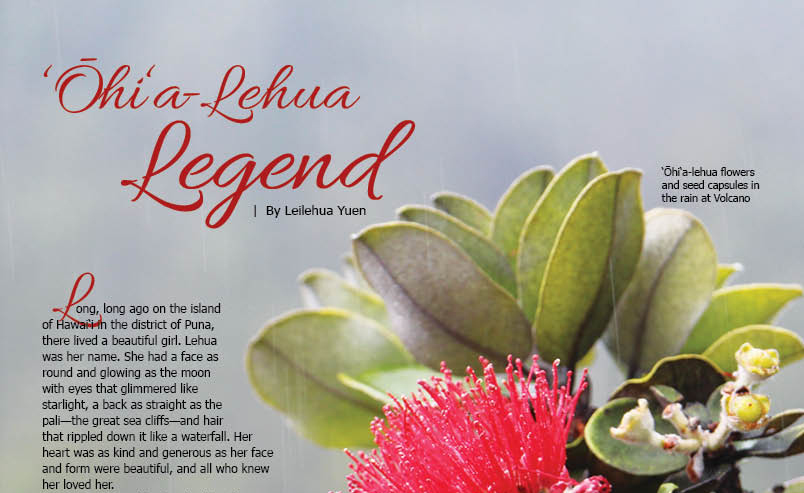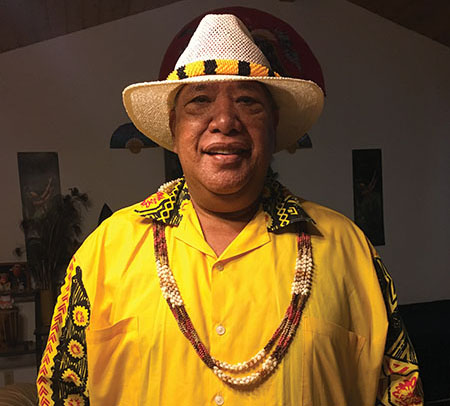
‘Ōhi‘a-Lehua Legend
By Leilehua Yuen
Long, long ago on the island of Hawai‘i in the district of Puna, there lived a beautiful girl. Lehua was her name. She had a face as round and glowing as the moon with eyes that glimmered like starlight, a back as straight as the pali—the great sea cliffs—and hair that rippled down it like a waterfall. Her heart was as kind and generous as her face and form were beautiful, and all who knew her loved her.
She was especially cherished by the young warrior ‘Ōhi‘a. His legs were as thick and strong as forest trees, his chest as broad as the pali, and his face was as smiling as the sun. His heart was brave and kind as his face and form were strong, and all who knew him loved him.
In the evening, ‘Ōhi‘a would play his ‘ohe hano ihu, his bamboo nose flute, sending the gentle melody to Lehua’s ears. She would follow it into the forest to meet him, and there they would admire the beauty of the night. Sometimes they strolled the forest paths by moonlight, sometimes wandering down to the shore to swim or surf and watch the phosphorescence of the tiny sea creatures they awakened.
Other times, they wandered early in the morning, watching the red-orange sun gild the leaves of the forest trees, listening to the morning birdsong. As ‘Ōhi‘a played his ‘ohe hano ihu, Lehua gathered the foliage and blooms of the forest and fashioned them into lei. After garlanding ‘Ōhi‘a and herself, she would playfully lead him back to the kauhale, the village, where they would greet their kūpuna and give them the fragrant lei.

Lehua’s ‘aumakua (personal god) was the little red ‘apapane. It loved to follow her into the forest and add it’s piping song to the melody of the flute. The little bird felt a great responsibility to care for the beautiful girl.
One evening, as ‘Ōhi‘a played his flute, before Lehua arrived at their meeting place, a different young woman appeared. She had a face as round and glowing as the moon with eyes that smoldered like fire, a back as straight as the pali, and hair that rippled down it like a waterfall. She approached ‘Ōhi‘a, who greeted her politely and then continued to play his flute until Lehua arrived.
The stranger watched the two wander away.
Another evening, as ‘Ōhi‘a again played his flute for Lehua, the stranger appeared. She seemed even more lovely than the first time. “‘Ōhi‘a, come and be mine!”
‘Ōhi‘a was only polite, and waited for his beloved Lehua. Again, the stranger watched as they went on their way.
On another evening, yet again the stranger appeared. She was even more beautiful than before, and the fire in her eyes glowed red. Again, ‘Ōhi‘a was polite, yet only waited for Lehua. “Come, ‘Ōhi‘a, leave that girl and be mine,” the stranger told him.
“I am sorry, but my heart belongs to Lehua,” ‘Ōhi‘a replied.
“Don’t you know who I am?” the stranger asked.
“You are the great goddess, the sacred woman, Pele,” ‘Ōhi‘a replied. “I am not worthy of you. I am content with my mortal love, Lehua.”
As the two spoke, Lehua arrived. ‘Ōhi‘a put his arms around her and held her close. Pele glared at the couple. The ground began to tremble. She stamped her feet and lava spurted forth, creating a fiery ring around the couple, with a clear path to the goddess.
“Leave her behind and come to me, and you will live,” she told ‘Ōhi‘a.
“I am sorry, oh Sacred One. Lehua is my very heart. If I were to leave her, she would die, and without her, I would die,” ‘Ōhi‘a replied.
“Then you shall die with her!” The lava from the curtain of fire began to ooze toward the couple. “Leave her and come to me!”
‘Ōhi‘a only held Lehua more tightly.
The lava came within inches of the pair. The little ‘apapane darted about them, flitting at the lava as if he would fight it back with his wings, but the molten rock was inexorable in its approach. ‘Ōhi‘a lifted Lehua above the glowing lava. It reached his feet and began to cover them. He lifted Lehua higher. The ‘apapane darted high in the air and flew away, chirping as loudly as it could.
The lava began to heap around ‘Ōhi‘a’s legs. He held his sweetheart even higher. By the time the ‘apapane returned, Lehua was sitting on ‘Ōhi‘a’s shoulders, caressing his face and weeping. The ‘apapane had tried to rally the forest spirits to rescue his charge and her sweetheart, but none of them had power enough to stop Pele.
What they, spirits of the forest did have power over was the growth of plants and forest creatures. ‘Ōhi‘a and Lehua were so beloved by the forest folk that the little spirits began to change the burning flesh of his legs to wood. His skin became bark. His arms became branches. Plucking Lehua from his shoulders, he held her high in his branches, up away from the lava which was crawling up his trunk. As he held her aloft, he felt his body stiffen.
He saw her hair billowing in the hot wind that blew across the lava. Sparks carried by the wind landed in her hair, looking like red and gold blossoms. Suddenly, the girl was gone, replaced by the flame colored flowers which bear her name and are held tenderly by the stalwart ‘Ōhi‘a.
Little ‘apapane continues to visit his beloved Lehua, and even today can be seen sweetly kissing her as she rests in ‘Ōhi‘a’s leafy arms.
Lei makers never pick these lovely blossoms on the way into the forest, only on the way out. If the lovers are separated as you enter the forest, Lehua grieves and droops. Her spirit is crushed, the spirits of the forest weep, bringing the rain, and the lei maker may become lost.
Instead, the lei maker travels into the forest, gives thanks for the beauty of the forest and asks permission to pluck the blooms. Then the sweet natured and generous pair will offer the blossoms freely and keep the path home clear of trouble.
The Tree Behind the Legend
The ‘ōhi‘a-lehua, Metrosideros polymorpha and M. macropus, is endemic to the Hawaiian islands. Most commonly red, the blossoms can range from creamy white to yellow to salmon, orange, and scarlet. It can grow as a small shrub or reach heights of some 100 feet. It can be found growing in areas from sea level to more than 7,000 feet elevation.
The blossom—pua lehua, blossom cluster—kīhene lehua, and the leaf bud—liko lehua, are important lei materials.
Customs
Traditionally, lei makers do not pick lehua on the way into the forest, only after they have gone in, performed their harvesting protocols, and are coming back out. The reasons for this custom are practical.
First, the areas where the lehua is most abundant and the kīhene most full are the misty rainforests of the islands. There, mornings are often bright and sunny, though as the day wears on, the clouds drift in and the misty rains begin to kiss the forests. As the clouds thicken, it becomes easy to get lost in the dense foliage. So, it is good to harvest early and be out of the forest before the clouds set in.
Second, the lehua blossoms and liko are filled with moisture and more sturdy when picked in the morning. Picked in the afternoon, they are already starting to wilt and will not last as long when fashioned into lei.
Third, if the blossoms are picked on the way in, they will spend at least twice as much time packed together being crushed and heated in the bag or basket in which they are carried, so they will not last as long, but will wilt more quickly when made into lei.
Legends teach us many things, and even a simple legend, like that of ‘Ōhi‘a and Lehua can teach us about natural history, botany, and weather systems.
We leave our story of the lehua with this saying:
Ka ua moaniani lehua o Puna, he ua no ke aloha.
The rain that brings the fragrance of the
lehua of Puna is a rain of love.
Photos courtesy Dr. J.B. Friday, 808.969.8254
Contact writer Leilehua Yuen



